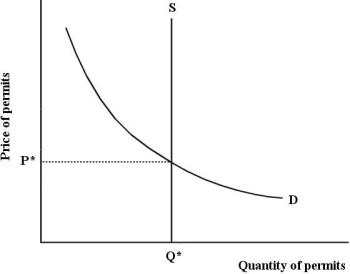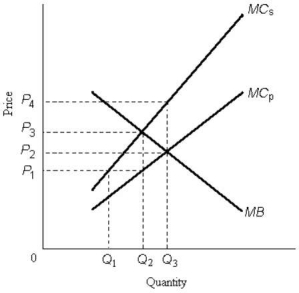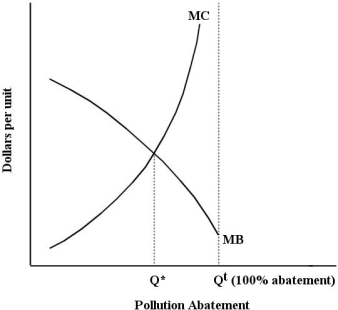A) $0
B) $650
C) $1150
D) $1300
E) $2250
Correct Answer

verified
Correct Answer
verified
Multiple Choice
Economists often argue that a system of tradable pollution permits is cost-effective because
A) firms facing a high marginal cost of abatement will not abate at all.
B) firms facing a low marginal cost of abatement will not abate at all.
C) firms facing a marginal cost of abatement lower than the permit price will not abate at all.
D) firms with a marginal cost of abatement lower than the permit price will buy permits and abate less.
E) firms will choose their abatement so that their marginal cost of abatement equals the price of a permit,which is the same for all firms.
Correct Answer

verified
Correct Answer
verified
Multiple Choice
If pollution is associated with the production of some good,then
A) the marginal social cost is less than the marginal social benefit.
B) the price of the good is equal to firmsʹ marginal private cost.
C) marginal social cost minus marginal private cost is negative.
D) marginal social cost minus marginal private cost is positive.
E) too little of the good is being produced by the firm.
Correct Answer

verified
Correct Answer
verified
Multiple Choice
When firms in an industry have fully internalized a production externality,
A) they produce at less than the optimal level of output.
B) they produce at more than the optimal level of output.
C) it is not possible to achieve allocative efficiency.
D) the marginal social cost is zero.
E) they bear the entire social marginal cost of production.
Correct Answer

verified
Correct Answer
verified
Multiple Choice
In a competitive market for tradable pollution permits,the quantity of permits (for a given amount of pollution) is set by ________ and the equilibrium price is determined by ________.
A) market forces; government policy
B) government policy; the average cost of pollution abatement
C) government policy; market forces
D) market forces; market forces
E) government policy; government policy
Correct Answer

verified
Correct Answer
verified
Multiple Choice
Suppose a per-unit tax is imposed on a firmʹs output which makes the marginal private cost of production equal to the marginal social cost.In this case,we can then say that
A) the externality has been fully internalized for that firm.
B) the firm will make losses as its costs have increased.
C) the internality has been externalized for that firm.
D) the firm will be forced by the extra cost burden to leave the industry.
E) the firm will not make any changes to its output decision.
Correct Answer

verified
Correct Answer
verified
Multiple Choice
The diagram below shows a market for tradable pollution permits.
 FIGURE 17-8
-Refer to Figure 17-8,which depicts the market for tradable pollution permits.If the environmental organization called ʺFriends of the Earthʺ buys a large quantity of pollution permits and permanently decides not to use them,then
FIGURE 17-8
-Refer to Figure 17-8,which depicts the market for tradable pollution permits.If the environmental organization called ʺFriends of the Earthʺ buys a large quantity of pollution permits and permanently decides not to use them,then
A) the demand curve shifts to the left,and the equilibrium price falls.
B) the supply curve shifts to the right,and the equilibrium price falls.
C) the supply curve shifts to the left,and the equilibrium price rises.
D) allocative efficiency is lost.
E) there is no impact on the equilibrium.
Correct Answer

verified
Correct Answer
verified
Multiple Choice
The figure below shows the marginal benefit to consumers,MB,the marginal cost to private firms,MCP,and the marginal cost to society,MCS,at each level of output of some good.
 FIGURE 17-1
-Refer to Figure 17-1.The socially optimal level of output is
FIGURE 17-1
-Refer to Figure 17-1.The socially optimal level of output is
A) zero.
B) Q1.
C) Q2.
D) Q3.
E) none of the above; there is no optimal output level.
Correct Answer

verified
Correct Answer
verified
Multiple Choice
Federal regulation aimed at reducing greenhouse-gas emissions by setting some maximum level of emissions from each firm
A) is the best approach because the costs of reducing emissions are different for each firm.
B) is the best approach because firms will quickly reduce air pollution.
C) will usually not produce the desired reduction in emissions at the lowest possible cost.
D) will achieve the largest but not the most efficient reduction in emissions.
E) will achieve the least reduction in emissions but be the most efficient.
Correct Answer

verified
Correct Answer
verified
Multiple Choice
If residential garbage collection were financed by charging households a fee per unit of garbage collected,rather than through general property taxation or a flat fee,you would expect
A) less concern about recycling and more concern about the high cost of garbage collection.
B) more recycling as households seek to minimize their garbage -collection bill.
C) higher costs for the municipality providing the garbage-collection service.
D) the administration cost to outweigh any other savings,thus rendering this idea inefficient.
E) inadequate revenue to pay for the garbage collection.
Correct Answer

verified
Correct Answer
verified
Multiple Choice
A paper mill discharges chemicals into a river which pollutes the shores of a downstream resort area.The private marginal cost,social marginal cost,and marginal benefit associated with the production of paper are given by the following equations: MCP = 5 + Q MCS = 10 + 2Q MB = 35 - 0.5Q The marginal social cost at the competitive free-market equilibrium is
A) 5.
B) 10.
C) 20.
D) 25.
E) 50.
Correct Answer

verified
Correct Answer
verified
Multiple Choice
The table below shows the marginal costs and marginal benefits associated with cleaning up a polluted landfill site.  TABLE 17-2
-Refer to Table 17-2.What is the net benefit to society of achieving the 100th percentage point of cleanliness of this land?
TABLE 17-2
-Refer to Table 17-2.What is the net benefit to society of achieving the 100th percentage point of cleanliness of this land?
A) $42 million
B) $4 million
C) -$4 million
D) $0
E) -$16 million
Correct Answer

verified
Correct Answer
verified
Multiple Choice
The figure below shows the demand and supply curves for pollution abatement.
 FIGURE 17-3
-Refer to Figure 17-3.The MC curve in this diagram is upward sloping because
FIGURE 17-3
-Refer to Figure 17-3.The MC curve in this diagram is upward sloping because
A) the marginal benefit from a given amount of abatement will be lower,the lower the level of pollution.
B) the marginal cost of additional units of pollution abatement is decreasing.
C) the marginal damage generated by additional units of pollution is decreasing.
D) the marginal benefit from a given amount of abatement will be higher,the higher the level of pollution abated.
E) the marginal cost of additional units of pollution abatement increases as the total amount of remaining pollution declines.
Correct Answer

verified
Correct Answer
verified
Multiple Choice
Economists generally view pollution as
A) an economic ʺbadʺ that must be eliminated entirely.
B) a negative economy.
C) a negative externality.
D) a positive externality.
E) a non-excludable good.
Correct Answer

verified
Correct Answer
verified
Multiple Choice
Economic analysis of the optimal amount of pollution is typically done in terms of the amount of pollution abated,as opposed to the amount of pollution produced.Why?
A) Because it is more practical to measure the marginal costs of pollution abated than of pollution produced.
B) Because governments and environmental authorities can produce more reliable data on pollution abated than pollution produced,which facilitates the economic analysis.
C) Because the abatement of pollution is a ʺgoodʺ to which we can more easily apply the concepts of supply and demand.
D) Because there are no marginal benefits of pollution produced,so it is necessary to study pollution abated in order to equate marginal benefits and marginal costs.
E) All of the above are correct.
Correct Answer

verified
Correct Answer
verified
Multiple Choice
A paper mill discharges chemicals into a river which pollutes the shores of a downstream resort area.The private marginal cost,social marginal cost,and marginal benefit associated with the production of paper are given by the following equations: MCP = 5 + Q MCS = 10 + 2Q MB = 35 - 0.5Q. The allocatively efficient level of output is ________ units.
A) 0
B) 10
C) 15
D) 25
E) 30
Correct Answer

verified
Correct Answer
verified
Multiple Choice
Given that different firms typically have different costs of pollution reduction,
A) tradable pollution permits will help to reduce the total costs of pollution abatement.
B) tradable pollution permits will help to reduce the marginal costs of pollution.
C) it is clear that only a moral solution can actually achieve pollution reduction.
D) there is a role for government to establish absolute limits on pollution.
E) the optimal emissions tax is thus easier to compute.
Correct Answer

verified
Correct Answer
verified
Multiple Choice
The diagram below shows the private and social marginal costs (MCP and MCS) and the social marginal benefits (MBS) of producing disposable diapers.
 FIGURE 17-2
-Refer to Figure 17-2.The net social benefit derived from the production and use of the last unit of disposable diapers is
FIGURE 17-2
-Refer to Figure 17-2.The net social benefit derived from the production and use of the last unit of disposable diapers is
A) at a minimum at Q0,because MCS exceeds MCP.
B) at a maximum at Q0,because that is where MCS equals MBS.
C) at a maximum at Q1,because that is where MCS equals MBS.
D) zero at Q0,because that is where MCS equals MBS.
E) zero at Q2,because that is where the externality is fully maximized.
Correct Answer

verified
Correct Answer
verified
Multiple Choice
Consider an oil company extracting oil from the Oil Sands in Northern Alberta.The production process generates greenhouse-gas emissions.At the socially optimal level of oil extraction,
A) the level of emissions will be zero.
B) the marginal cost of the emissions will be equal to the social marginal benefit derived from the extracted oil.
C) the marginal cost of the emissions will be more than the social marginal benefit derived from the extracted oil.
D) the social marginal cost of the oil extraction will be equal to its social marginal benefit.
E) the social marginal cost of the oil extraction will exceed its social marginal benefit.
Correct Answer

verified
Correct Answer
verified
Multiple Choice
A paper mill discharges chemicals into a river which affect the shores of a downstream resort area.The private cost,social cost,and marginal benefit associated with the production of paper are given by the following equations: PMC = 5 + Q,SMC = 10 + 2Q,and MB = 35 - 0.5Q.What level of emissions tax (dollars per unit of output produced) would provide the paper mill with the incentive to produce at the allocatively efficient level of output?
A) $5
B) $10
C) $15
D) $20
E) $25
Correct Answer

verified
Correct Answer
verified
Showing 21 - 40 of 126
Related Exams